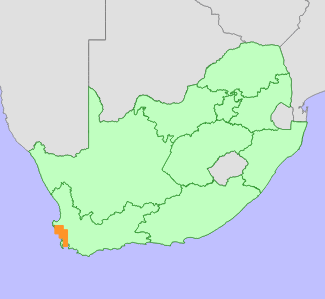|
Scientific Name | Diosma dichotoma P.J.Bergius |
Higher Classification | Dicotyledons |
Family | RUTACEAE |
National Status |
Status and Criteria | Endangered A2c; B1ab(i,ii,iii,iv,v); C2a(i) |
Assessment Date | 2012/07/06 |
Assessor(s) | J.E. Victor, D. Raimondo & V. Zikishe |
Justification | A past population reduction of at least 50% is estimated based on extensive habitat loss over the past 150 years - within three generations of this long-lived resprouter. EOO 3363 km², between seven and 16 small, severely fragmented subpopulations remain. Surveys indicate that remaining subpopulations are small, consisting of no more than 100 mature individuals, and the total population size is estimated to be fewer than 1000 mature individuals. This species continues to decline due to ongoing habitat loss to urban expansion, crop cultivation and competition from unmanaged alien invasive plants. |
Distribution |
Endemism | South African endemic |
Provincial distribution | Western Cape |
Range | Faure to Hopefield. |
Habitat and Ecology |
Major system | Terrestrial |
Major habitats | Langebaan Dune Strandveld, Cape Flats Sand Fynbos, Atlantis Sand Fynbos, Hopefield Sand Fynbos |
Description | Sandy plains, close to the coast. |
Threats |
| Loss of habitat to urban expansion, and continuous habitat degradation and fragmentation due to agricultural transformation in the form of grazing and crop fields, are severe threats to this species. It is now confined in small fragments that are moderately to highly infested by unmanaged alien invasive plants. |
Population |
A population reduction of at least 50% is estimated based on 56% habitat loss on coastal lowlands within Diosma dichotoma's range in the past 150 years (three generations). Diosma dichotoma is currently known from only seven confirmed surviving subpopulations, five of which have been counted, indicating that subpopulations are very small, with two consisting of less than 10 mature individuals, one less than 50 and the other less than 100 mature individuals. About nine other subpopulations, known from historical records, have not yet been surveyed, but all occur in areas now extensively transformed, and it is not certain whether they are locally extinct or not. The total population size of the seven confirmed surviving subpopulations is estimated to be no more than 400 mature individuals, and if the nine uncertain subpopulations are included, the total population size is estimated to be no more than 1000 mature individuals. This species continues to decline due to ongoing habitat loss and degradation.
|
Population trend | Decreasing |
Assessment History |
Taxon assessed |
Status and Criteria |
Citation/Red List version | | Diosma dichotoma P.J.Bergius | VU B1ab(i,ii,iii,iv,v) | 2012.1 | | Diosma dichotoma P.J.Bergius | VU B1ab(i,ii,iii,iv,v) | Raimondo et al. (2009) | | Diosma dichotoma P.J.Bergius | Data Deficient | Victor (2002) | | Diosma dichotoma P.J.Bergius | Vulnerable | Hilton-Taylor (1996) | |
Bibliography |
Victor, J.E. 2002. South Africa. In: J.S. Golding (ed), Southern African plant Red Data Lists. Southern African Botanical Diversity Network Report 14 (pp. 93-120), SABONET, Pretoria.
Williams, I. 1974. Studies in the genera of the Diosmeae (Rutaceae): 4. Journal of South African Botany 40:275-290.
Williams, I. 1975. Studies in the genera of the Diosmeae (Rutaceae): 5. Journal of South African Botany 41:167-186.
Williams, I. 1975. Studies in the genera of the Diosmeae (Rutaceae): 6. Journal of South African Botany 41(4):239-268.
Williams, I. 1982. Studies in the genera of the Diosmeae (Rutaceae): 14. A review of the genus Diosma L. Journal of South African Botany 48(3):329-407.
|
Citation |
| Victor, J.E., Raimondo, D. & Zikishe, V. 2012. Diosma dichotoma P.J.Bergius. National Assessment: Red List of South African Plants version 2024.1. Accessed on 2025/11/14 |
 Comment on this assessment
Comment on this assessment


